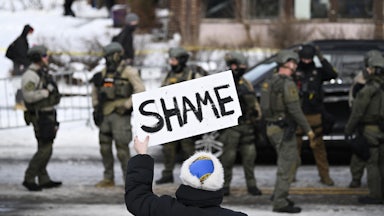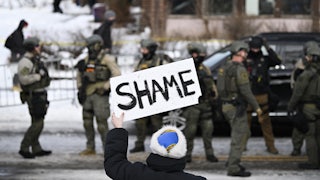There is only one Supreme Court of the United States, but after listening to yesterday’s oral arguments in Ramirez v. Collier, you might be forgiven for wondering if there are now suddenly two of them, running amok across the judicial landscape. The Supreme Court with which most Americans are familiar is extraordinarily friendly to religious liberty claims and the interests of spiritually motivated plaintiffs. The Supreme Court that heard oral arguments in Ramirez, on the other hand, regarded those claims with suspicion and disinterest.
John Henry Ramirez, the plaintiff, is a death-row prisoner in Texas. The Lone Star State had permitted a spiritual adviser to be present in the execution chamber when prisoners died for the last 40 years but abruptly changed this rule in 2019. Ramirez and other prisoners sued the state to reverse this rule change and won concessions from the state in exchange for dropping the lawsuit. But as the months drew closer to Ramirez’s execution date, Texas began imposing new restrictions on the adviser’s ability to speak to and touch a prisoner as he dies, prompting Ramirez to relaunch his lawsuit.
When someone brings a religion-related claim before the justices, they almost always win. A law-review study published earlier this year found that the Roberts court, which began in 2005 and continues to this day, ruled in favor of such claims 81 percent of the time. By comparison, the Rehnquist court, which lasted from 1986 to 2005, ruled in favor of religion-related claims merely 58 percent of the time. Religious groups have enjoyed more than a few high-profile victories in recent years, including a landmark ruling against “Blaine amendments” and a narrow victory for a Catholic adoption agency that wanted to refuse to work with same-sex couples.
Ramirez’s claims, however, were met with a surprising outpouring of disdain. “You have told us you would be satisfied if Pastor Moore touches Mr. Ramirez’s foot,” Justice Samuel Alito told Ramirez’s lawyer. “But what’s going to happen when the next prisoner says that I have a religious belief that he should touch my knee? He should hold my hand? He should put his hand over my heart? He should be able to put his hand on my head? We’re going to have to go through the whole human anatomy with a series of cases. And you haven’t said anything about what you want exactly with respect to audible prayer. What type of prayer? When? How loud? What exactly do you want to start out with?”
Justice Brett Kavanaugh had similarly out-of-sorts inquiries about the degree to which judges should probe the sincerity of various religious claims. “This is a potential huge area of future litigation across a lot of areas—[the] sincerity of religious claims,” he told him. “How do we question those? Some things that people have talked about are the incentives someone might have to be insincere, behavioral inconsistencies … the religious tradition of the practice. What do we look at to check sincerity? Because that’s a very awkward thing for a judge to do, to say: I want to look into the sincerity of your claim. But our case law says we must do that.”
Justice Clarence Thomas expressed the same point even more bluntly. “If we think Mr. Ramirez has changed his request a number of times, and has filed last-minute complaints, and if we assume that that’s some indication of gaming the system, what should we do with that with respect to assessing the sincerity of his beliefs?” he asked. At the center of each justice’s line of inquiry was a very simple assumption: The court would be overwhelmed with religious freedom claims if it ruled in Ramirez’s favor and that such a circumstance would be deeply undesirable.
It is hard to imagine these justices asking if any other religious plaintiffs were “gaming the system” or questioning the sincerity of their beliefs so aggressively. But the court’s conservative justices, in their campaign to end what they describe as a “guerrilla war on the death penalty,” have subordinated other rights and values to serve an even higher goal: ensuring that the state can conveniently administer lethal injections to prisoners whenever and however it desires.
Ramirez’s story can be directly traced back to Dunn v. Ray, a different death penalty case that reached the court in 2019. Domineque Ray, a Muslim prisoner in Alabama, challenged a state policy that required the prison chaplain, a Protestant Christian minister, to be present in the execution chamber when he died, shortly before his scheduled execution. Ray sought to have an imam of his own faith present instead. The religious discrimination claim was so obvious that the Eleventh Circuit Court of Appeals stayed Ray’s execution while litigation took place, with one judge writing that “it looks substantially likely to us that Alabama has run afoul of the Establishment Clause of the First Amendment.”
Then the Supreme Court intervened, in stunning fashion. At Alabama’s request, the court’s five conservative justices voted to overturn the stay, and Ray was executed a few hours later. The justices issued an unsigned two-sentence explanation that effectively blamed Ray for not bringing the case sooner. “On November 6, 2018, the State scheduled Domineque Ray’s execution date for February 7, 2019,” the majority wrote. “Because Ray waited until January 28, 2019 to seek relief, we grant the State’s application to vacate the stay entered by the [Eleventh Circuit].”
Justice Elena Kagan, writing for herself and the court’s three liberal justices at the time, strenuously denounced her colleagues’ move. “Given the gravity of the issue presented here, I think that decision profoundly wrong,” she wrote in a dissenting opinion. Kagan highlighted the Establishment Clause problems with Alabama’s actions and laid out how precedent supported her side. But her most withering critique of the majority came from her rebuttal of the majority’s timeline for Ray’s appeal.
I also see no reason to reject the Eleventh Circuit’s finding that Ray brought his claim in a timely manner. The warden denied Ray’s request to have his imam by his side on January 23, 2019. And Ray filed his complaint five days later, on January 28. The State contends that Ray should have known to bring his claim earlier, when his execution date was set on November 6. But the relevant statute would not have placed Ray on notice that the prison would deny his request. To the contrary, that statute provides that both the chaplain of the prison and the inmate’s spiritual adviser of choice “may be present at an execution.” It makes no distinction between persons who may be present within the execution chamber and those who may enter only the viewing room. And the prison refused to give Ray a copy of its own practices and procedures (which would have made that distinction clear). So there is no reason Ray should have known, prior to January 23, that his imam would be granted less access than the Christian chaplain to the execution chamber.
The majority’s unsigned decision implied that Ray should have raised his claim when he found out his execution date in November. But as Kagan easily establishes, Ray could not have known about the problem until he was verbally informed of it by the warden two months later, in January—less than a fortnight before his execution date. Kagan was not offering a difference of opinion about how to read a statute or interpret a precedent; she was telling the majority that they were plainly wrong about the sole factual basis they gave for overriding the Eleventh Circuit and letting the state execute Ray.
It’s worth noting here that the justices typically get the chance to read each other’s writings in a case before they are published by the court. That allows the other justices to make edits to their own writings, respond to any critiques, and even change positions in some cases. The justices haven’t publicly described what happened behind the scenes in Ray, and the public may not learn more until individual justices’ papers become available later this century. But as I observed at the time, either the conservative justices didn’t know that Kagan’s dissent had proven them factually wrong, which would still suggest a troubling level of sloppiness by them in a life-or-death situation, or they simply didn’t care that they were wrong.
The court’s decision in Ray drew widespread criticism from commentators on the left and the right. It also created an unusually public rift between the justices over death-penalty cases and eleventh-hour appeals. The following month, the court stayed the execution of Patrick Murphy, a Buddhist inmate in Texas who had challenged a policy that only allowed Christian or Muslim clergy in the execution chamber. Kavanaugh, who voted for the stay, tried to distinguish the case from Ray by claiming, in a concurring opinion, that Murphy had raised an equal-treatment claim himself, while the Eleventh Circuit had found one in Ray’s case on its own accord. That hypertechnical hair-splitting was not the court’s stated reason for overturning Ray’s stay one month earlier, and Kavanaugh ignored the factual error in the reason it actually offered.
It still wasn’t enough for Justice Samuel Alito, who wrote a dissent in Murphy’s case, joined by Thomas and Justice Neil Gorsuch, where he argued that both men should have been denied a stay of execution because of timing reasons. “This Court receives an application to stay virtually every execution; these applications are almost all filed on or shortly before the scheduled execution date; and in the great majority of cases, no good reason for the late filing is apparent,” Alito wrote. “By countenancing the dilatory litigation in this case, the Court, I fear, will encourage this damaging practice.”
The court’s decision in Murphy’s case prompted Texas to remove spiritual advisers from the execution chamber altogether, apparently in hopes of resolving the equal-treatment claim forever, which in turn prompted Ramirez to bring his litigation to the court again and led to the oral arguments heard on Tuesday. This time, the justices had ample time and sufficient briefing to weigh the issues before them. And yet at oral arguments, they were once again preoccupied with the possibility that some other capital-defense lawyer somewhere might bother them with a vaguely similar complaint at the last minute at some future date.
In fairness, the Supreme Court’s unique role in overseeing the machinery of death cannot be an easy one in which to participate. They are regularly asked to decide life-or-death matters, sometimes on the day of the scheduled execution itself, and likely have to do so over the phone while at home with their families. It is no surprise that, until recently, this macabre cycle drove many of the justices to reject the death penalty altogether: Of the seven justices who voted to revive capital punishment in 1976, three of them—Lewis Powell, Harry Blackmun, and John Paul Stevens—later renounced it from the bench or in retirement. Justices’ votes in specific cases obviously do not count after the fact, but if they did, that 1976 decision would have eventually gone 5–4 the other way.
The current justices’ plight might be more sympathetic, however, if they did not make litigation so difficult in death-row cases in general. During oral arguments in a case on botched lethal injections in Oklahoma in 2015, for example, Alito asked whether it was “appropriate for the judiciary to countenance what amounts to a guerrilla war against the death penalty,” referring to legal challenges to specific execution methods. His majority opinion in that case then set a nearly insurmountable threshold for prisoners to prove that a particular drug or method would violate the Eighth Amendment. Last month, Oklahoma carried out its first lethal injection since the court’s ruling in 2015. The prisoner, John Grant, died while “convulsing and vomiting,” according to witnesses.
The justices’ questions in oral arguments can sometimes be rhetorical; they don’t necessarily reflect their own conclusions or always show how they might vote in the eventual ruling later this term. Kavanaugh later noted that it would be “awkward” for judges to question the sincerity of prisoners’ religious beliefs. It’s possible that a majority of justices will recognize that religious rights don’t end at the execution chamber; indeed, they may be more important there than anywhere else. But given the court’s clear disdain for death-row prisoners and the lawyers who represent them, it also wouldn’t be surprising if the Supreme Court once again placed the state’s convenience in executing someone—and the justices’ desire to reduce their own workload—above everything else.










